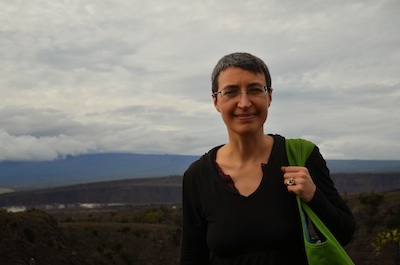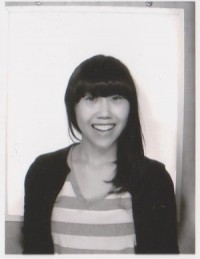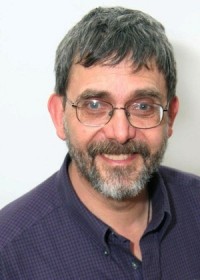Yiddish erotic poetry. It’s not a phrase that trips off the tongue, perhaps because Celia Dropkin may have been its only practitioner. There were Yiddish poets and writers in Eastern Europe and America who addressed risqué topics, but few, if any, in ways as explicit as Dropkin.

Faith Jones, a Vancouverite who teaches library science and who was previously a Yiddish bibliographer in the New York Public Library’s Jewish division, will discuss Dropkin and the craft of translating Yiddish erotic poetry at the first-ever Limmud Vancouver Feb. 9, one of 42 presentations on a hugely diverse array of topics over a full day. With two other scholars, Jones translates Dropkin’s work into English.
Dropkin (1887-1956) came to New York from Belarus in 1912, and immersed herself in the Bohemian life that was thriving there. It was at this time, as well, that she shifted from writing in Russian and began a career as a noted Yiddish poet and writer. This switch in vernacular appears to have been for practical reasons, not cultural or political ones, Jones explained.
“She wrote in Russian because she was educated in the gymnasium, in the Russian education system, and her literary influences were largely Russian,” said Jones. “To her – she came from a very poor family – being able to go to gymnasium was really quite an accomplishment and the Russian language was itself a status symbol. Her ability to use it artistically was something that she would have been very proud of.”
Once in New York, though, her audience would have been overwhelmingly Yiddish-speaking, and so it was probably a practical decision to switch. “I don’t think Yiddish to her was the beginning and end of being Jewish,” said Jones.
While nobody appears to have become rich writing poetry in Yiddish, Dropkin was comparatively a “commercial” success in terms of being widely read. She made some cash, particularly during the Depression, writing relatively mainstream short stories. Nevertheless, said Jones, “Her poetry was her real art, but you could not make a living on Yiddish poetry.”
Why, though, was this traditionally educated woman so apparently ahead of her time on sexual matters?
“She was educated in this different way – she was educated in a Russian way, not in a Jewish way,” Jones noted. “She also had a fair bit of freedom.” Dropkin’s father died when Celia was a child, and her mother was not particularly religious. The household appears to have been fairly open-minded and attuned to modernity. Her writing was different as well, Jones speculates, because she was a woman and also because she did not have the traditional Hebrew education that male poets of her time did.
“She was kind of freed because of being a woman,” said Jones. “She didn’t have a classical Hebrew education and so she was able to make up a different way of being a writer and wasn’t as constrained by expectations that, if you are a Jewish writer, your writing would be laced with references to the Bible and things like that.”
There were other poets writing about sexual matters, but in a much more veiled manner. A female Orthodox poet, for example, expressed her sensual ideas through depictions of hair, which would have resonance from an Orthodox female perspective. Dropkin was not so subtle.
“Dropkin had a poem, for example, in which it certainly seems to me that what she is describing is sadomasochistic sex. I don’t think she’s at all attempting to cover that up,” Jones said. “Other poets would just refer to the bed and some longing and maybe there is a stroke.”
Dropkin was published in the Yiddish journals of the day, despite the sometimes-scandalous nature of her work. “A scandal is always good for circulation,” Jones laughed. “So they were happy to have it. They were Bohemians, so they were going to publish that sort of thing.” There was a sense, among male critics and other poets, Jones said, that Dropkin’s work might bring disrepute to the Jews – even though, because it was written in Yiddish, only Jews could have read it. But criticism of Dropkin from other Jews, mostly male, was probably due to more straightforward reactions.
“It was shocking, a woman speaking about her physical body, her desires, her lust,” Jones said. “That was too much for them.”
Dropkin’s art, it seems, imitated her life. “She was really, really a Bohemian,” Jones said. “She really lived that life pretty fully, notwithstanding being married, which did not appear to have been any kind of difficulty. So, for example, I was able to meet with [Dropkin’s now deceased oldest son] many times and interview him, and I asked at one point, ‘Was your father at all upset by your mother’s sort of freewheeling life, having lovers, having a social life that was sort of separate from his?’ He said, ‘No it didn’t really bother him,’ and I had the impression that, you know, it went both ways.”
Jones warns attendees at next month’s Limmud conference that her session will not be appropriate for those who blanch at strong language and sexual imagery. But while the topic is erotic poetry and the craft of translating it, Jones said she has a broader ambition in presenting the topic.
“I would like people to think about re-envisioning our forbearers as people who were more like us. We need to really explore the people in our past and, as a historian, this is what I hope for most: that people will explore the past, understanding that these people were not like us, but in other ways were very much like us.”
***
About the same time that Dropkin was writing steamy poems in New York, the klezmer scene was heating up Montreal. Emily Lam, an independent researcher dedicated to the history of Jewish music in Montreal, will present on the subject at the Limmud conference – and some of her findings will surprise.

One of the first things to understand about klezmer music is that those who traditionally played it didn’t call it klezmer, Lam said. The word klezmer simply means musician. So when musicians were performing a tune, they called it by the kind of tune it was – a freylech, a doyna, a hora. For present-day practitioners of the traditional Jewish tunes, however, as for the rest of us, klezmer is a handy shorthand.
“It’s what they call it because everybody calls it that these days,” said Lam, who has interviewed as many Montreal musicians from the early part of the 20th century as she has been able to track down. Among these artists, mostly now in their 80s and 90s, the “true” klezmorim were those from Eastern Europe and the musicians who learned directly from those masters. What we call klezmer, according to Lam, is a music that represents “homeland and folk … synonymous with a particular place and time that was physically left behind, yet … instantly accessible through the music’s soundscapes, which connected the Jewish immigrant to their shtetl and the Yiddishkeit of their ancestral past.”
As klezmer has seen a dramatic revival in recent decades, Lam said her interviewees are pleased that the music is being performed and heard again, but they invariably say something is missing.
“Everybody is very happy that more people know about this kind of music, more people know about the history of it,” Lam said. “My interview subjects are happy that they still get to hear it if they choose to. They can go to concerts, they can go to festivals and events. They’re really happy about that. However, they feel that when they hear it, something about it isn’t the same. They always express that there is a lack of a certain feeling, a feeling within the music that they can’t hear, that they did hear with other musicians – their predecessors, their mentors. So when they hear things from the so-called revival, while they enjoy it, something about it is lacking and they always express … there’s just this feeling that’s missing.”
The progression of klezmer involved the original immigrants teaching it to their children, with a predictable downturn as the decades passed. “New immigrants want to carry on those traditions because that’s what they know,” Lam said. “There was a tradition that you learn this music and how to play it from your father and your uncles, relatives. The people that I interviewed were the children of the true klezmorim [the immigrants who brought the music from Eastern Europe]. They carried out the tradition but, obviously, as times change, people’s interests, especially children of new immigrants, what they wanted, how they see their lives, was different from Eastern Europe.”
Second-generation Canadians might have wanted the traditional tunes at their weddings, perhaps because their parents wanted it, but they also wanted more contemporary, popular music.
“As time progressed, there were less traditional tunes and more contemporary tunes,” said Lam. “It’s part of being an immigrant and having children in a new country. You try to instil these traditions. They’re going to choose their own path.”
But traditions can morph in unexpected ways. Weddings and bar mitzvahs may be a showcase for klezmer, but making a living in early- to mid-20th century Montreal as a musician meant being ready to take any gig that came along. Fortunately, klezmer can be a heavily improvisational musical form, similar to the vibrant jazz scene that was emerging in Montreal.
“If you were a klezmer, you were a versatile musician,” Lam said. “So [for] lots of Jewish musicians, especially going into the ’30s and onward, there’s lots of crossing over with jazz music in Montreal.”
Lam started her research during her undergraduate studies at the University of Ottawa, mentored by Prof. Rebecca Margolis, who specializes in Yiddish culture in Canada, among other topics. Lam, who grew up in Peterborough, Ont., is the daughter of immigrants who fled Vietnam during the war there. She does not directly attribute her interest in this subject to her family’s experience, but she sees a parallel. “I certainly can understand this sort of looking for something that reminds you of your homeland,” Lam said.
***
Many people can name the most famous Jewish baseball players – precisely because there have been so few of them. Despite this, there are striking parallels between the practice of Judaism and the practice of baseball, according to Vancouver rabbi and University of British Columbia faculty member Hillel Goelman, who will present at the Limmud conference.

“I’m not going to just talk about Sandy Koufax and Hank Greenberg,” he said. “That’s not what the discussion is about. The discussion is that there are aspects of Jewish spiritual understandings, about deeper meanings of Judaism and some of the deeper meanings of baseball and that we can learn about one from the other.”
There is a teaching in Jewish spirituality that views everything as being at an intersection of time and space and a journey of the soul, said Goelman. “Our whole history is about a journey through space, whether it’s Abraham to Egypt, or the Jewish people coming out of Egypt, or making aliyah to the Land of Israel,” he said. “In Jewish spirituality, in kabbalah, we believe that there are different realms of reality and that each of those can correspond to another level of reality that you can get higher and higher and higher until you end up at the highest, which is getting back home, and home is in the wholeness and the holiness of the home space.”
Baseball is also about an individual’s odyssey, he said. “Baseball is really about the individual, where it’s the individual who scores the points, scores the runs. The ball doesn’t have to go into a hoop or a net or anything like that. It’s the individual who goes through a journey through space,” he said.
There’s also an intergenerational aspect, he added, in that Judaism is passed down from parents to children. The love of baseball is also conveyed transgenerationally. In addition, Judaism and baseball both have “two aspects of gaining knowledge,” Goelman said. One aspect focuses on the legalistic proscriptions – “what you’re commanded to do, commanded not to do, the appropriate behaviors” – the other is a very rich mythological lore.
“There is a mythology in Judaism, there is a mythology in baseball, that goes beyond the literal meaning of what’s happening,” he said. “Judaism gives us some very powerful metaphors and images and practices, which really resonate very deeply with us in terms of what is the Sabbath and why is that important and what are the High Holidays and why are they important, what is a bar mitzvah and why is that important, why is a wedding ceremony important. There is a lot of symbol and symbolism and mythology. And in baseball, as well, there’s a lot of symbol and symbolism and mythology. I think that’s why many of us find it so riveting.”
The recent news of New York Yankee Alex Rodriguez’s use of performance-enhancing drugs offers a vignette into another aspect of mythology.
“Here’s another giant among us who has fallen, who has succumbed to whatever kind of temptation it was, of ego, of achievement, of seeing himself above and beyond the rules,” Goelman said. “And this is sort of the karmic consequences of someone who exceeds the boundaries and doesn’t really understand the beauty and the mythology of the game.”
LimmudVan ’14 is the first annual Limmud event here. The phenomenon, which began in London, has spread to dozens of cities worldwide. The Vancouver conference, which sold out weeks in advance, will feature more than 40 separate presentations on a huge array of topics. See next week’s issue for more on Limmud. Full details at limmudvancouver.ca.
Pat Johnson is a Vancouver writer and principal in PRsuasiveMedia.com.
